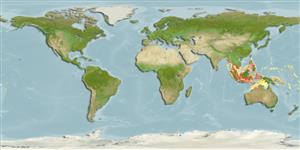Elasmobranchi (squali e razze) (sharks and rays) >
Myliobatiformes (Stingrays) >
Dasyatidae (Stingrays) > Urogymninae
Etymology: Himantura: Greek, iman, imantos = thong, strap + Greek, oura = tail (Ref. 45335).
Environment: milieu / climate zone / distribuzione batimetrica / distribution range
Ecologia
marino demersale. Tropical
Indo-Pacific: off India, Indonesia, and Gulf of Thailand.
Size / Peso / Age
Maturità: Lm ? range ? - ? cm
Max length : 120 cm WD maschio/sesso non determinato; (Ref. 58048)
Short description
Chiavi di identificazione | Morfologia | Morfometria
This species is characterized by absence of skin fold on the ventral surface of the tail; quadrangular profile of disc; whip-like tail variably banded; adults' upper surface with widely spaced, honeycomb-like reticulations; juveniles with relatively large spots on disc (Ref. 58048).
Body shape (shape guide): other.
Found inshore on soft substrates. Viviparous, with histotrophy. Few biological information is available, diet presumably consists of crustaceans and small fishes. Caught occasionally in demersal tangle nets; meat, skin (of high value) and cartilage are utilized (Ref. 58048).
Life cycle and mating behavior
Maturità | Riproduzione | Deposizione | Uova | Fecundity | Larve
White, W.T., P.R. Last, J.D. Stevens, G.K. Yearsley, Fahmi and Dharmadi, 2006. Economically important sharks and rays of Indonesia. [Hiu dan pari yang bernilai ekonomis penting di Indonesia]. Australian Centre for International Agricultural Research, Canberra, Australia. (Ref. 58048)
IUCN Red List Status (Ref. 130435: Version 2025-1)
Human uses
Pesca: scarso interesse commerciale
Strumenti
Special reports
Download XML
Fonti Internet
Estimates based on models
Preferred temperature (Fonte Biblio.
123201): 27.9 - 29.3, mean 28.7 °C (based on 630 cells).
Phylogenetic diversity index (Fonte Biblio.
82804): PD
50 = 0.5002 [Uniqueness, from 0.5 = low to 2.0 = high].
Bayesian length-weight: a=0.01023 (0.00486 - 0.02155), b=3.06 (2.87 - 3.25), in cm total length, based on LWR estimates for this (Sub)family-body shape (Ref.
93245).
Trophic level (Fonte Biblio.
69278): 3.6 ±0.5 se; based on size and trophs of closest relatives
Fishing Vulnerability (Ref.
59153): Very high vulnerability (90 of 100).
🛈
